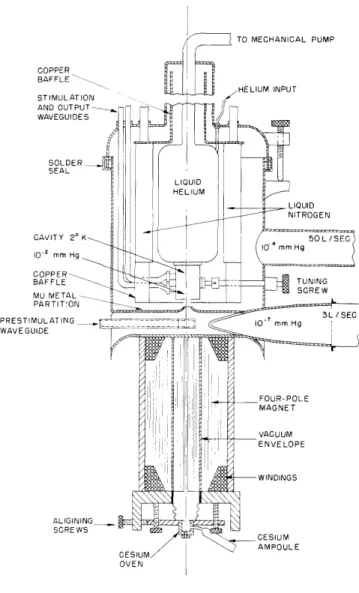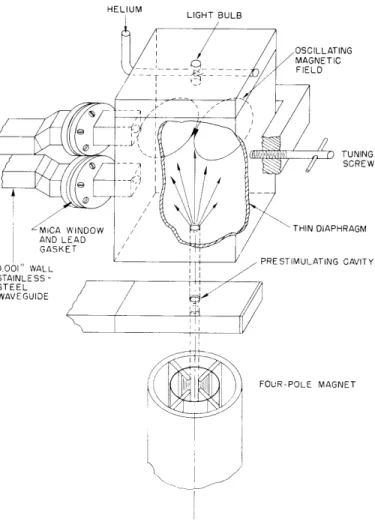VII. ATOMIC BEAMS
Prof. J. R. Zacharias Dr. R. F. C. Vessot D. S. Edmonds, Jr.
Prof. J. G. King D. D. Babb E. P. Hilar
Prof. C. L. Searle H. H. Brown, Jr. G. W. Stroke
Dr. S. Ketudat B. DiBartolo R. Weiss
A. HELIUM-GAS-MODERATED ATOMIC-BEAM MASER
The linewidth of frequency standards that use stimulated emission or absorption of radiation by atoms or molecules depends mainly upon the time interval during which the atom is available for observation in an unchanged state. In atomic-beam frequency standards that are based on separation of atoms that have undergone transitions, the bandwidth can be decreased by lengthening the distance between the two rf sections. But in a maser, where the radiation itself is observed, rather than the change in the magnetic moment that is caused by resonance radiation, the particles must remain within the field of the radiation-detecting device over the whole observation time. Exchanges of energy between similar particles and with the walls of the vessel must be avoided.
We plan to try the following scheme for lengthening the lifetime of a beam of state-selected atoms. A beam of atoms from an oven, separated according to their state by passing through inhomogeneous magnetic or electric fields, is introduced into a region containing a gas that has a spherically symmetrical ground state; this gas must be kept very cold. Helium appears to be a good choice. The atoms collide elastically with the gas and reach thermal equilibrium, then eventually diffuse through the gas and hit a wall of the containing vessel. A further increase in lifetime might be obtained by the correct choice of wall-coating material.
The atom chosen for the present experiment is cesium 33 The transition chosen is the 9192. 631830 ± 10 mc/sec line from the F=4, mf=0 transition, which has no first-order dependence with the field and has a second-first-order dependence of 426 cycles/gauss .
Cesium atoms emerge from an oven at the base of the apparatus and are physically separated according to state by a four-pole magnetic lens that focuses only the F=4, mf=0 hyperfine level. The atoms travel into the cavity and rattle about for approximately 1 sec before striking a wall or otherwise changing their states. A mean life of 1 sec, which allows a linewidth of approximately 1 cps, should give a reading accuracy of one
12
part in 10 . Emission can be stimulated in one of two places, either directly at the cavity or before entry. If it is stimulated before entry, the advantage is that only power emitted by the atoms is observed from the cavity. This can be important at low power levels.
This research was supported in part by Purchase Order DDL-B222 with Lincoln Laboratory, which is supported by the Department of the Army, the Department of the Navy, and the Department of the Air Force under Contract AF19(122)-458 with M. I. T.
(VII. ATOMIC BEAMS) COPPER BAFFLE STIMULATION AND OUTPUT-WAVEGUIOES SOLDER SEAL 10-2 mm Hg COPPER BAFFLE WAVEGUIDE TO MECHANICAL PUMP ,HELIUM INPUT FOUR-POLE MAGNET VACUUM ENVELOPE ALIGINING SCREWS CESIUM, OVEN
Fig. VII-1.
The maser.
(Not drawn to scale.)
The apparatus, constructed of stainless-steel sheet (16-gauge), heli-arc welded, consists of two vacuum systems connected by a small hole. Figure VII-1 shows the arrangement. A resonant cavity, cooled to Z2 K by contact with a bottle of liquid helium at low pressure, is kept filled with helium at 10- mm Hg. To avoid excessive radiation loss, this assembly is surrounded by a hollow cylindrical vessel containing liquid air. Leakage of helium from the cavity is kept pumped out to at least 10- mm Hg by a 4-inch oil diffusion pump. This low-vacuum region is separated from the high-vacuum region by a metal partition pierced by a small hole through which the beam enters. The oven and the state-selection magnet occupy the lower system, which oper-ates at 10- 7 mm Hg or better.
The oven is a monel cylinder with a single round hole (diameter, 0. 024 inch) col-limated to a half-angle of approximately 1'; it has a window on the bottom. The whole
(VII. ATOMIC BEAMS)
HELIUM
HELIUM LIGHT BULB
OSCILLATING
00' WAL - . IFIEL/
FOUR-POLE MAGNET
0
TUNINGS - -- SCREW
Fig. VII-. Detail
of the detection cavity.
THIN
DIAPHRAGM
AND LEAD0PRESTIMULATING CAVITY
STAINLESS-WAVEGUIDE
FOUR-POLE MAGNET
Fig. VII-2. Detail of the detection cavity. (Not drawn to scale.)
assembly is mounted to the magnet by means of a bellows arrangement that facilitates
alignment.
A small light bulb buried in the top of the cavity provides a light source
for visual alignment of the cavity and the oven with respect to the magnet before the
cesium ampoule is broken; that is, while the system is cold.
A four-pole magnet was chosen for separating the upper m f=0 state from the
other 15 hyperfine states. It produces a radial field Bradial=-ar. Over the region
0- 3000 gauss (roughly) the F=4, mf=0 state has a moment m that is proportional to
the field; that is, m=cB. Consequently the force, which is proportional to the product
of the gradient and the moment, behaves as F radial=a cr and is directed towards the
center for the atom in the upper state.
This condition allows atoms of a given axial
velocity to be focused, and all atoms that have this velocity and are in the F=4, mf=0
state that enter the lens will form an image of the oven aperture at the cavity entrance.
The magnet, which is 29.4 cm long, has an acceptance half-angle of
10.Object and
image distances (measured to the entrance of the magnet, both 5 cm) give a magnification
(VII. ATOMIC BEAMS)
of unity for atoms having a velocity v mp2. 7 10 cm/sec.
mp
A numerical integration over the range of beam velocities 0. 9 to 1.2 vmp predicts that at least 1.4 X 108 atoms per second will enter the cavity in the desired state.
Radiation is detected in the usual manner by means of a rectangular cavity operating in the 2, 1, 0 mode (see Fig. VII-2). This mode, which has an arbitrary length in one direction, provides a large volume of in-phase magnetic field that can couple to the beam along the central axis of the cavity. Since a lobe of scattered atoms with a length that depends upon gas pressure is expected, the cavity was made 6. 7 cm long with a square cross section of 3. 65 cm. Power for stimulation and output is fed through special low-thermal conductivity waveguides made of 0. 001-inch stainless steel. Tuning is possible by deforming one side of the cavity by means of a screw.
The X-band receiver consists of a phase-locked klystron and a radar i-f strip having a noise figure of approximately 2 and a bandwidth of 1. 5 mc/sec at 30 mc/sec. The signal from the i-f strip is heterodyned and fed into a 200-kc amplifier having a band-width of 20 cps. If the over-all noise figure is assumed to be 10, then the number of particles per second required to release their energy coherently to double the noise is about 106. Further reduction in bandwidth will improve the sensitivity.
The maser is in the process of construction.

